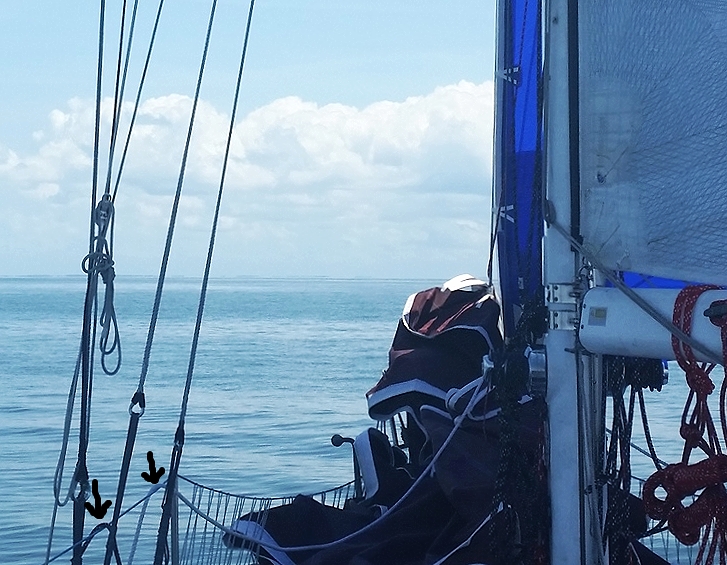The shrouds are subject to chafe from the jib sheets and sails. The Cap Shrouds can be chafed by overlapping headsails when tacking, as well as the lazy sheets. These are some easy points to protect the shrouds:
Do not back an overlapping headsail
Chafe sleeves
Lazy sheets
Sheet block positioning
Place longer than necessary lashings
Overlapping headsails will rub on the cap shrouds on every tack, this is going to happen. As the sail slides past the shroud, the forces acting will not be too great, so the damage will be minimal and should not be too much of a concern. Backing the headsail though is not recommended as this will lead to increased pressure and lots of movement as the sail wiggles around against the shroud while under the pressure of the wind. This will damage the sail very quickly as well as chafe the shroud. If you must heave to, either roller furl the sail to bring the clew forward of the shrouds or switch to a non overlapping headsail.
If you find that the leech of the sail is chafing the shrouds, you can always install a chafe sleeve over the affected areas. This will protect against future damage. I would not recommend placing chafe sleeves if they are not needed because sail chafe is not going to cause structural damage in a short amount of time. The chafe sleeves are rather cumbersome to install. If you have too much length, they are going to be baggy and look poorly. If you have too little, then you will be short on one end. I personally feel that the added cost and headache of preemptively adding a chafe sleeve to cap shrouds is unnecessary.
The big danger with cap shroud chafe will come from the sheets. These lines are going to saw back and forth on a small area with considerable force. They could destroy themselves and damage the stay if left unchecked. You want to make sure that the lazy sheet is not ridding up and down on the windward stay, as this rubbing will damage the outer layer of the stay.
While the lazy sheet can damage the stay over time, the working sheet can damage it even faster. Sheet block position is critical as it will either protect or destroy your running and standing rigging. Your sheet blocks should guide the sheet to the clew without rubbing into any stays. If you have to decide between perfect sheeting angle or chafe free positioning, I would absolutely vote for the chafe free position. What is more important? Sailing a little faster because of perfect lead angles, or keeping your rigging free from damage?
You want to have the sheet blocks laid out so that they do not chafe when the sail is loaded under normal sailing angles, as well as when the sail is backed. In my situation, my jib sheets would lay against the shrouds when hove to. For this reason, I will not heave to with the jib, but instead I use the staysail which will not chafe anything when the sail is backed.
Most chafe from sheets will occur close to the deck, where it is easily inspected and managed. The bottom of the stay in the area of the lifelines is at greatest risk from chafe as many lines will rub past it: sheets, dock lines, deck gear, people, ect. This area will benefit from a sacrificial section just like the service placed on the headstay. The stay can simply end a bit above the lifelines and the lashings will take all of the abuse. If they begin to look chafed, the lashings are very cheap and easy to replace compared to replacing the whole stay.
Where the shroud passes through the spreader tips, I apply service as it is stronger than the chafe sleeve and not as slippery. After the rigging is finally tuned, I then seize the spreader tip to the shroud so that it doesn't budge.
Important things to remember when looking at chafe on the cap shrouds are:
If you see it rubbing a little, it will eventually damage it
The more load a line is under, the quicker it will cause damaging chafe
Lighter loads tend to chafe a larger area less aggressively
Stronger loads tend to chafe a smaller area more aggressively
Just be sure to keep an eye out for anything rubbing and make the necessary changes as soon as you spot a problem.




